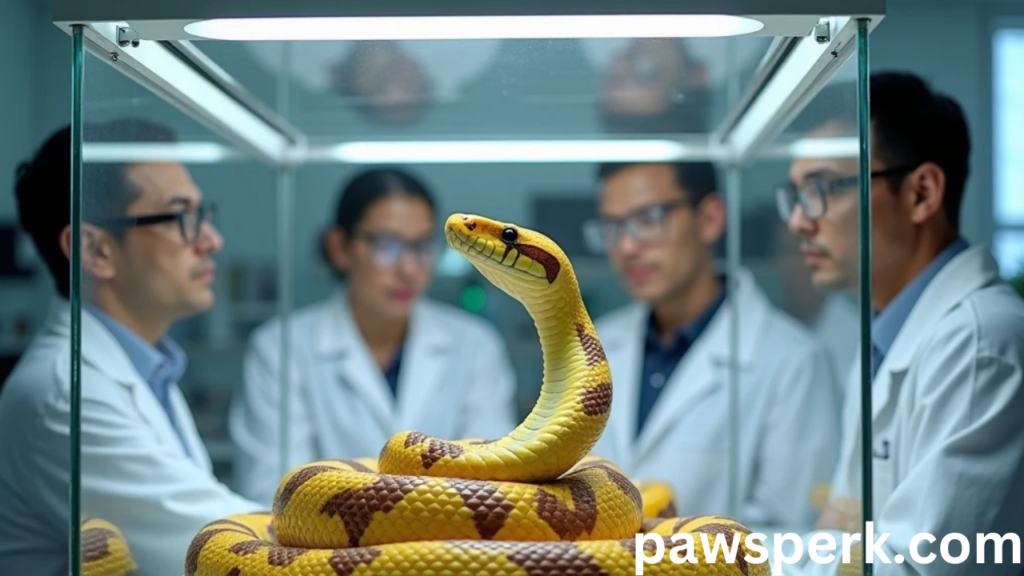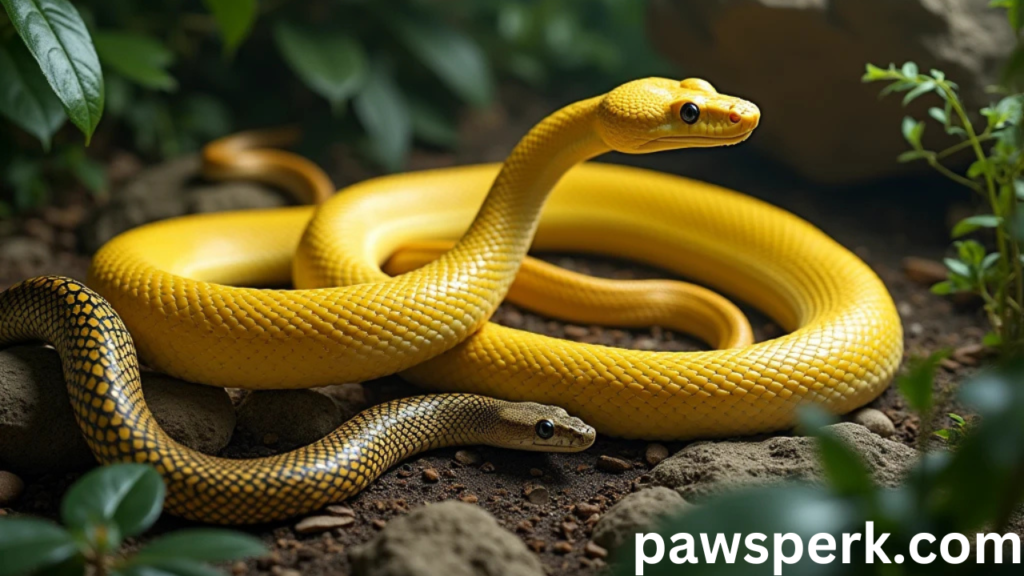The banana ball Pythons is a favorite among snake lovers for its vibrant colors and unique patterns. This stunning morph has captured the hearts of many reptile enthusiasts. In this blog post, we’ll explore its key traits, care requirements, and special features to help both new and experienced owners better understand this incredible snake.
What is a banana ball Python?
Bright yellow spots set on a tan or light brown base hue define this morph. As they mature, these snakes may develop small dark spots, or “freckles,” adding to their unique appearance. The banana morph is often confused with the coral glow morph due to their similar color patterns; however, they are genetically distinct yet share many visual traits.
Genetics Behind the Morph
The banana ball Python is classified as a co-dominant morph. Accordingly, there is a 25% possibility of creating a Super Banana—a banana with a more subdued tint than its parent—when it is bred with another banana. These snakes’ genetic composition permits a wide range of pairings with other morphs, resulting in an impressive array of stunning color patterns and looks.
Physical Characteristics
Adult banana ball pythons usually reach a length of 2 to 5 feet and a weight of 5 to 8 pounds. With the right care, they can live up to 30 years.
You may also like: Cat Grass: A Simple Addition for a Healthier Cat
Here are some key physical traits:
- Coloration: Bright yellow patches on a tan or light brown base.
- Size: Generally between 2 and 5 feet long.
- Weight: Adult snakes typically weigh between 5 and 8 pounds.
- Freckles: Dark spots may develop as they age.
Care Requirements
Caring for a Banana Ball Python involves understanding its habitat needs, diet, and health considerations. What you should know is as follows:
Habitat Setup
Establishing a suitable habitat is essential for your banana ball Python’s health and welfare. Here are some essential habitat requirements:
- Tank dimensions: Adults should consume at least 60 gallons.
- The temperature is as follows: a cooler location should be around 75°F, and a basking zone should be around 85°F. Maintain humidity levels in the range of 50% to 60%.
- Substrate: For bedding, use coconut fiber or aspen shavings.
- Dietary Needs: Banana Ball Pythons are carnivorous and primarily feed on rodents. This is a fundamental feeding guideline:
- Prey Size: Offer prey that is about the same size as the widest part of the snake’s body.
- Frequency of Feeding: Adults can be fed every 10–14 days, but juveniles should be fed every 5–7 days.
Maintaining ideal weight and health for your snake requires regular feeding.
Health Considerations
Banana Ball Pythons are normally healthy; however, they can develop some diseases. Frequent veterinary examinations are recommended.
Common health issues include:
- Respiratory infections: often caused by improper humidity or temperature.
- Mites: external parasites that can affect skin health.
Keeping an eye on your snake’s health will enable you to identify any possible problems early.

Behavior and Temperament
Banana ball pythons are widely recognized as excellent pets, especially for beginners, due to their calm and gentle nature. Their reputation for being easy to handle and non-aggressive makes them a top choice for those new to keeping reptiles. While every snake has its unique personality, most banana ball pythons are docile and manageable, making interactions with them enjoyable and stress-free. Regular handling is key to maintaining this calm temperament, as it helps your snake remain accustomed to human contact. This consistent interaction builds trust between you and your pet and ensures the snake feels secure in its environment. By dedicating time to gentle handling, you can create a positive experience for both yourself and your banana ball python, fostering a strong bond and a happy, well-adjusted pet.
Unique Traits
Ball pythons are well-known for their fascinating defensive behavior called “balling.” When these snakes feel threatened or scared, they curl their bodies into a tight ball and tuck their heads safely inside, protecting their most vulnerable part. This unique behavior not only showcases their natural survival instincts but also plays a significant role in their name, “ball python.” This defensive mechanism is one of the many reasons these snakes are adored by reptile enthusiasts, as it reflects their gentle and non-aggressive nature. Understanding this behavior helps owners recognize when their ball python may feel stressed or unsafe, ensuring proper care and handling to keep these snakes happy and comfortable in captivity.
Breeding Insights
For those interested in breeding banana ball Pythons, understanding genetics is key. Breeding two bananas can yield various outcomes:
- Normal bananas: bright yellow patches on a tan base.
- Super Bananas: more muted colors with less distinct patterns.
This genetic variability makes breeding both exciting and unpredictable.
Conclusion
The Banana Ball Python stands out not just for its stunning appearance but also for its manageable care requirements and friendly disposition. Whether you are considering adding one to your collection or simply admiring these beautiful creatures from afar, understanding their needs and characteristics enhances appreciation for this remarkable morph. In summary, the Banana Ball Python offers reptile enthusiasts an engaging pet that combines beauty with ease of care. With proper attention to habitat setup, diet, and health monitoring, these snakes can thrive in captivity for decades, providing joy and fascination along the way.


